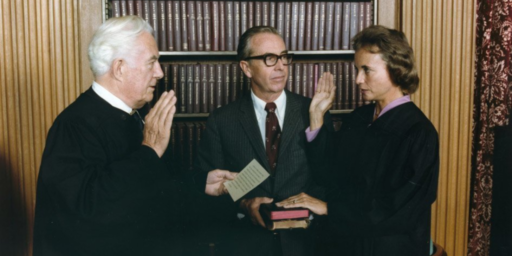Sandra Day O’Connor, 1930-2023
The first woman to serve on the Supreme Court is gone at 93.

Fred Barbash, Washington Post, “Sandra Day O’Connor, pathbreaking woman on Supreme Court, dies at 93“
Sandra Day O’Connor, the first female U.S. Supreme Court justice, whose independence on a court that was often ideologically divided made her the pivotal vote in numerous closely contested cases and one of the most powerful women of her era, died Dec. 1 in Phoenix. She was 93.
The cause was complications from advanced dementia — probably Alzheimer’s disease — and a respiratory illness, according to an announcement by the court. Justice O’Connor had said in 2018 that she had dementia and was exiting public life.
In her nearly quarter-century as a justice, from her swearing-in on Sept. 25, 1981, after being appointed by President Ronald Reagan, to her retirement on Jan. 31, 2006, to care for her husband, who had Alzheimer’s, Justice O’Connor tried to avoid what she called “giant steps you’ll live to regret.”
She rejected the idea of eliminating the right to abortion, for example, in part because “an entire generation has come of age” relying on it. She co-wrote the principal opinion in Planned Parenthood of Southeastern Pennsylvania v. Casey (1992), setting a new standard for judging abortion cases but reaffirming the core holding of Roe v. Wade, which legalized abortion in 1973.
Justice O’Connor’s successor, Samuel A. Alito Jr., would in 2022 excoriate her decision for having “enflamed debate and deepened division,” in his majority opinion wiping out abortion rights.
Reagan appointed Justice O’Connor as a conservative. But she would not qualify for the right flank on today’s court. She wrote an opinion justifying race-conscious admissions in law schools. She supported, for the most part, traditional boundaries between church and state. And while usually deferential to the prerogatives of the states, Justice O’Connor had little tolerance for state laws that trampled on equality.
A Texas law banning sodomy, she wrote as she concurred in a 2003 ruling overturning it, was “directed toward gay persons as a class.” A law based on “moral disapproval of that class … runs contrary to the values” of the Constitution, she wrote inLawrence v. Texas.
She never went far enough in any area of the law to fully satisfy either conservatives or liberals of the day, Republicans or Democrats. And many Democrats never forgave her for siding with George W. Bush inBush v. Gore, which settled the outcome of the 2000 presidential election. After her retirement, she voiced misgivings that the court had gotten involved in the case.
Her 2002 memoir, “Lazy B: Growing Up on a Cattle Ranch in the American Southwest,” was a bestseller. In it, she described a youth unlike that of any of her contemporary Supreme Court justices, roping calves and fixing trucks along with doing homework on a vast southwestern ranch. She recalled awakening one morning to see “an enormous ball of fire in the distance” and a “dark cloud” forming and rising in the sky. Only later did she learn she had witnessed the dawn of a new age: the first atomic bomb test in Alamogordo, N.M., on July 16, 1945.
O’Connor arrived at the court from Arizona with no overarching philosophy or agenda, no affiliation with a movement or cause and no previous position in anyone’s administration in Washington. She had served as a state legislator in Arizona and as a judge. Her name had appeared on few lists of potential nominees put forth in the media or by advocacy groups.
She was not well-known nationally, except eventually as the first female appointee, a break from two centuries of nothing but men, a distinction that made her instantly a historic figure, her face recognized across the country, her personal story symbolic of the experiences of professional women.
Despite a stellar law school record, she described being offered only secretarial jobs at law firms. When Chief Justice Warren E. Burger escorted O’Connor down the steps of the court after her investiture, he said to the reporters assembled below: “You’ve never seen me with a better-looking justice.”
Linda Greenhouse, New York Times, “Sandra Day O’Connor, First Woman on the Supreme Court, Is Dead at 93“
Sandra Day O’Connor, the first woman on the United States Supreme Court, a rancher’s daughter who wielded great power over American law from her seat at the center of the court’s ideological spectrum, died on Friday in Phoenix. She was 93.
[…]
Although William H. Rehnquist, her Stanford Law School classmate, served as chief justice during much of her tenure, the Supreme Court during that crucial period was often called the O’Connor court, and Justice O’Connor was referred to, accurately, as the most powerful woman in America.
Very little could happen without Justice O’Connor’s support when it came to the polarizing issues on the court’s docket, and the law regarding affirmative action, abortion, voting rights, religion, federalism, sex discrimination and other hot-button subjects was basically what Sandra Day O’Connor thought it should be.
That the middle ground she looked for tended to be the public’s preferred place as well was no coincidence, given the close attention Justice O’Connor paid to current events and the public mood. “Rare indeed is the legal victory — in court or legislature — that is not a careful byproduct of an emerging social consensus,” she wrote in “The Majesty of the Law: Reflections of a Supreme Court Justice,” a collection of her essays published in 2003.
When President Ronald Reagan named her to the Supreme Court in 1981 to fulfill a campaign promise to appoint the first female justice, she was a judge on a midlevel appeals court in Arizona, where she had long been active in Republican politics, though she had friends in both parties. Fifty-one years old at the time of her nomination, she served for 24 years, retiring in January 2006 to care for her ailing husband. As the court moved to the right during that period, her moderate conservatism made her look in the end like a relative liberal.
“Liberal” was undoubtedly not her self-image, but as the court’s rightward shift accelerated after her retirement — her successor, Samuel A. Alito Jr., was notably more conservative — she lamented publicly that some of her majority opinions were being “dismantled.”
“What would you feel?” she responded to a questioner in 2009, who asked her reaction to decisions that had undermined some of her rulings.
Justice O’Connor spent an active retirement, sitting as a visiting judge on federal appeals courts around the country and speaking and writing widely in support of two causes, judicial independence and civics education. She also catered to her six grandchildren, taking them on trips and writing two children’s books based on her own colorful childhood on a remote Arizona ranch.
Nina Totenberg, NPR, “Sandra Day O’Connor, first woman on the Supreme Court, dies“
Retired Supreme Court Justice Sandra Day O’Connor, the first woman to serve on the court, died Friday in Phoenix, Ariz., of complications related to advanced dementia, probably Alzheimer’s, and a respiratory illness, the court announced. She was 93 years old.
[…]
While on the court, O’Connor was called “the most powerful woman in America.” Because of her position at the center of a court that was so closely divided on so many major questions, she often cast the deciding vote in cases involving abortion, affirmative action, national security, campaign finance reform, separation of church and state, and states’ rights, as well as in the case that decided the 2000 election, Bush v. Gore — a decision she later hinted she regretted.
Her retirement allowed President George W. Bush to appoint a much more conservative justice, Samuel Alito, in her place, and that appointment took the court in a far more conservative direction.
O’Connor’s retirement was the last step in a long balancing act between family and career. In 2005, O’Connor’s husband was suffering from Alzheimer’s disease, and when the ailing Chief Justice William Rehnquist told her that he was putting off his retirement, O’Connor decided that with her husband’s health declining, she could not wait and risk the possibility that the court would have two vacancies at once.
As it turned out, that’s what happened anyway. O’Connor announced her retirement, and the chief justice died weeks later. She stayed on for another six months while confirmation hearings proceeded, and in a cruel twist of fate, her husband’s health took such a precipitous downward turn that he had to be placed in a home, and later died.
But on that June day in 2005 when O’Connor announced her retirement, she wept; she later made quite clear that she regretted the decision to step down.
I was a 15-year-old kid when Reagan appointed O’Connor, so she’s been a major figure my entire adult lifetime. She was obviously a pioneering figure but also a deep disappointment to so many who voted for Reagan, precisely because she was non-ideological and, indeed, seemed to go out of her way to find the middle ground.
When Harriet Miers was appointed by President George W. Bush many years later, I argued vehemently against it, partially on the grounds that she was a relative mediocrity who would be another O’Connor. In recent years, I’ve come to change my mind on both Miers and O’Connor. While there’s something to be said for a brilliant legal mind with a finely honed judicial philosophy, in the mold of the late Justices Antonin Scalia and Ruth Bader Ginsburg, I’ve come to see the virtue of those with political experience and more concern for the practical implications of their rulings.






I forget where I read it, but somebody wrote that Justice Brennan’s aggressiveness pushed O’Connor to the right and Scalia’s aggressiveness pushed her to the left. RIP Justice.
I think the problem with a brilliant legal mind is that they have the ability to justify anything they want to justify.
The consequential Warren Court was just the opposite. Earl Warren was essentially a politician and not considered a towering legal scholar.
O’Connor turned out to be a far better justice than many on the left would have predicted. In today’s court, she’d be considered a liberal. It should be noted, that O’Connor was not a product of the Harvard/Yale Law school, SC clerk, Federal judge, appeals court judge track. Her background had her seeking decisions that were best for America, though they may have been with a conservative lean.
Whatever legacy she might have wanted to have, Bush v. Gore dominates it all. Everyone who signed onto that is forever tarnished.
The Supremes were wading into politics, making up law, and putting their fingers on the scale. If you’re making up law in an election dispute, the only law to make up is “recount everything.”
It was a blow to democracy that continues to be felt to this day. Her legacy was to weaken America.
I had assumed she died long ago, but I hope her final years were filled with horror, pain, sadness and regret.
@Gustopher:
My first reaction was Bush v Gore.
At the time I didn’t think much of it, but I did read afterwards she said she didn’t want to be replaced by a nominee from a Democratic president. I don’t vouch for the truthfulness of this statement, but it does color my perception of O’Connor.
BTW, I think if a full recount had been carried out, Bush the younger would still have won. Large elections very rarely change upon a recount (small elections do). And the difference in popular vote totals was small enough to be seen as a technical tie.
That was my second reaction.
What absolute unmitigated bullshit.
I’m glad she lived long enough to see the man she retired for give her the finger as he stripped rights away from women. I hope that tortured her till her last day.
I’ve always thought guessing whether famous people were still alive or dead would make for a fun party games. Alas, I would most certainly have guessed wrong yesterday for O’Connor.
Despite a couple major mistakes, I never wished her ill. There are far worse people on Earth (yes, especially her successor).
Translation:
She naively thought her job was to interpret the law as enacted. Since the law leans liberal, that left her badly out of touch with the faction on the Court (led by Scalia) who saw their role as finding any excuse to rule in favor of specific reactionary prejudices.
O’Connor was the first self-hating woman that I became aware of in my teenage years (I’m roughly the same age as James)
The idea that a woman would support conservative politics was absurd to me even then. I kind of understood why some men would choose to support and grow a system that gave them unearned power and wealth, but the idea that a woman would be forced to glom themselves onto a man if they were to share in the spoils seemed wholly unfair even in my teen years.
Having grown up Episcopal, we didn’t talk about such things, but as it turned out I was surrounded by such women in my community and didn’t even know it. Of course gay people were irrelevant too.
I shudder at how simply we looked at the world, reducing everything to the most basic categories and forcing everyone to get in line.
O’Connor was both a perpetrator and a victim of this system.